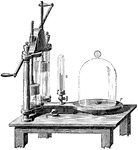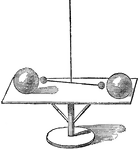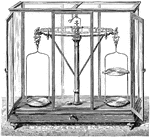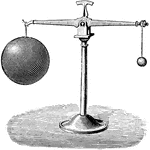The General Physics ClipArt gallery offers 239 images showing principles of the science and proof of theorems. Physics is the science of basic concepts such as energy and force.
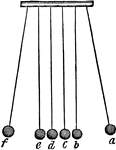
Action and Reaction
"This will be understood, when we consider that the reaction of b is just equal to the action of a,…

Aeolipile
"An instrument illustrating the expansive force of steam generated in a closed vessel, and escaping…

Air-Pump
"The general scheme of Geisler's pump is shown here. A and B are pear-shaped glass vessels connected…
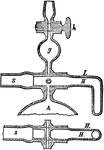
Air-Pump
"The general scheme of Geisler's pump is shown here. A and B are pear-shaped glass vessels connected…

Air-Pump
"This was invented in 1865 by H. Sprengel. The instrument, in its original (simplest) form, consists…
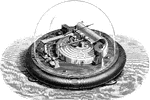
Aneroid Barometer
This barometer depends upon the changes in form of a think metallic vessel partially exhausted of air,…
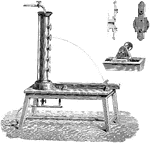
Apparatus for verifying Torricelli's Theorem
This figure represents an apparatus frequently employed for illustrating some of the consequences of…

Composition of Parallel Forces
A simple apparatus called the arithmetical lever for illustrating the laws of parallel forces.
Gravitational Attraction
"Two cannon balls, when suspened by long cords, so as to hang quite near each other, are found to exert…

Capillary Attraction
All liquids that wet solids that are placed in them will be lifted, while those that don't will be pushed…
The Atwood Machine
The Atwood machine (or Atwood's machine) was invented in 1784 by Rev. George Atwood as a laboratory…

Atwood's Machine
"Atwood's Machine. This difficulty has however been overcome by a curious piece of machinery invented…
Atwood's Machine
"Machine designed by Atwood to allow the measurement and calculation of the velocities of falling bodies…
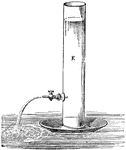
Backward Movement of Discharging Vessel
This experiment illustrates the law of action and reaction, which asserts that momentum cannot be imparted…
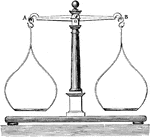
Balance
In the common balance there is a stiff piece of metal called the beam, which turns about the sharp edge…
Spiral Balance
"A form of balance in which the weight of the body under examination is measured by the stretching (torsion)…

Balancer Toy Illustration
The stability of the "balancer" depends on the fact that, owing to the weight of the two leaden balls,…

Beam Strength
"When the load is uniformly distributed on a beam of any cross-section, it will sustain a load twice…

Cylindrical Beam
"The maximum safe load in pounds that any cylindrical beam is capable of sustaining at the middle when…
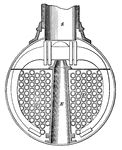
Locomotive Blast
Image of a locomotive from the front. E is the exhaust pipe, and S is the smokestack. T are tubes through…

Falling Bodies
If a lead ball and a piece of paper are placed into a glass tube in which all the air has been exhausted,…
Proof of Boyle's Law for Expanding Air
This apparatus is used to prove Boyle's Law which describes the relationship between the product pressure…
Glass bulb
"An air thermometer consists essentially of a large glass bulb at the upper end of a tube of small but…

Buoyancy Chambers
Buoyancy chambers, hydrostatic principle. Illustration of an unsuccessful scheme for a perpetual-motion…

Burst Bladder
A glass cylinder is open at the bottom, having a piece of bladder or thin indian-rubber tightly stretched…

Cantilever
"A cantilever is a beam, bar, rod, etc., fixed at one end and subjected to a transverse stress. It has…
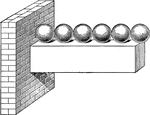
Cantilever
"When the load is uniformly distributed on a cantilever of any cross-section, it will sustain a load…
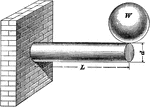
Cylindrical Cantilever
"The maximum safe load in pounds that should be allowed at the end of any cylindrical cantilever is…

Capillarity
Capillarity. On the left, water is higher in the smaller tubes due to adhesion. On the right, mercury…
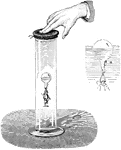
Cartesian Diver
A Cartesian diver or Cartesian devil is a classic science experiment, named for René Descartes,…

Center of Gravity
"Why does a person carrying a weight upon his back stoop forward? In order to bring the center of gravity…

Center of Gravity
"Why does a person carrying a weight upon his back stoop forward? In order to bring the center of gravity…
Center of Gravity
"The center of gravity, in any body or system of bodies is that point upon which the body, or system…

Center of Gravity
"But if one of the balls be heavier than the other, then the centre of gravity will, in proportion,…

Center of Gravity
"In a body of equal thickness, as a board, or a slab of marble, but otherwise of an irregular shape,…

Center of Gravity
"If w and W, fig. 3, be two bodies of known weight, their center of gravity will be at C." —Hallock…
!["The part of the body in which the centre of gravity is situated, may be found, in some cases, by balancing it on a point. Thus the centre of gravity of the poker represented [here] lies directly over the point on which it is balanced." —Quackenbos 1859](https://etc.usf.edu/clipart/36300/36326/centergrav_36326_mth.gif)
Center of Gravity
"The part of the body in which the centre of gravity is situated, may be found, in some cases, by balancing…

Center of Gravity
"When such a surface is irregular in shape, suspend it at any point, so that it may move freely, and…

Center of Gravity of Standing Blocks
"Where five blocks are placed in this position, the point of gravity is near the centre of the thrd…
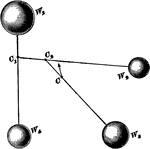
Compound Center of Gravity
"Find the center of gravity of two of the bodies, as W1, and W4, in fig 4. Assume that the weight of…
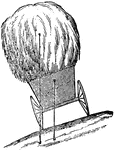
Center of Gravity of a Load of Hay
"A load of hay...upsets where one wheel rises by little above the other, because it is broader on the…
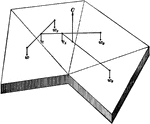
Center of Gravity of an Irregular Plane
"To find the center of gravity of any irregular plane figure, but of uniform thickness throughout, divide…
!["When a line of direction falls within the base, a body stands when not, it falls... On the same principle, a load of stone may pass safely over a hillside, on which a load of hay would be overturned [as shown by the line of direction in this illustration]." —Quackenbos 1859](https://etc.usf.edu/clipart/36300/36329/lod_cog_36329_mth.gif)
Line of Direction from the Center of Gravity of an Object
"When a line of direction falls within the base, a body stands when not, it falls... On the same principle,…
!["When two bodies of equal weight are connected by a rod, the centre of gravity will lie in the middle of that rod. When two bodies of unequal weight are so connected, the centre of gravity will be nearer to the heavier one. These principles are illustrated [here], in which C represents the centre of gravity." —Quackenbos 1859](https://etc.usf.edu/clipart/36300/36328/cog_rod_36328_mth.gif)
Center of Gravity of Rod with Weights
"When two bodies of equal weight are connected by a rod, the centre of gravity will lie in the middle…
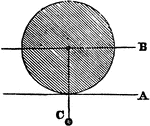
Center of Gravity of a Rolling Ball
"When a ball is rolling on a horizontal plane, the centre of gravity is not raised, but moves in a straight…
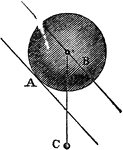
Center of Gravity of a Ball Rolling on an Incline
"If the plane is inclined downwards, the ball is instantly thrown into motion, because the centre of…
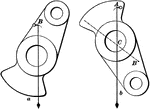
Center of Gravity of a Solid
"In a body free to move, the center of gravity will lie in a vertical plumb-line drawn through the point…
Center of Inertia
"But, suppose the same bar or iron, whose inertia was overcome by raising the centre, to have balls…
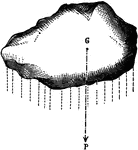
Center of Mass
"A body's center of mass is the point about which all matter composing the body may be balanced. It…
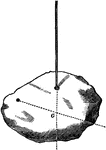
Finding the Center of Mass
"Let any irregularly shpaed body, as a stone or chair, be suspended so as to move freely. Drop a plumb…
Centrifugal Force
"When a vessel containing water is whirled rapidly round, why does not the water fall out when the vessel…
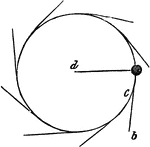
Centrifugal Force
"Suppose a cannon ball, tied with a string to the centre of a slab of smooth marble, and suppose an…
